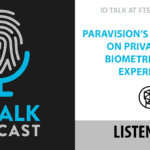
Ever AI’s announcement that it was rebranding as Paravision this past summer arrived alongside some other big news: the company’s facial recognition algorithm had attained the top ranking in the National Institute of Standards and Technology’s ongoing Face Recognition Vendor Test. Coming after Ever AI had tied for first in the NIST’s Wild Images category for 1:1 matching last year, the new achievement signaled Paravision’s rapid advancement as a developer of sophisticated computer vision technology.
Now, in a new interview with FindBiometrics VP of Digital Content Susan Stover, Paravision CEO Doug Aley explains the significance of these kinds of achievements and of NIST testing in general. But he also delves into another thing that sets his company apart in the world of computer vision tech – a strong commitment to certain privacy and ethical standards in how its technology can be used. Aley goes so far as to name one major market in which his company will probably never operate, and proceeds to delve into the key markets and verticals upon which Paravision is focused, and Aley’s thoughts on the emergence of biometrics legislation concerning facial recognition tech.
Read the full interview with Doug Aley, CEO, Paravision:
Susan Stover, VP of Digital Content, FindBiometrics: Great to speak with you today, Doug. Let’s start off with some background. How did Paravision get its start and what are the company’s big goals in the biometric space?
Doug Aley, CEO, Paravision: Thank you for having us here today, Susan. We really appreciate it.
Paravision got its start creating our own in-house computer vision models for another business we had. Our models were incredibly accurate and we received enough inquiries from other organizations that we ended up productizing them for consumption by enterprises. The results of our first submission to the NIST Face Recognition Vendor Tests (FRVT) were so positive that it validated our decision to pursue a business focused on providing computer vision tools to enterprise developers as well.
We have three main goals in the biometrics space. Firstly, we want to offer highly accurate face recognition for mission-critical applications across a range of deployments (including at the edge, on-premise, and in the cloud). This has been a gap in the market as accuracy, speed, and efficiency don’t always go hand-in-hand. It has traditionally been difficult to put high performance models on edge devices due to hardware constraints; as a result, we often see competitors offering high speed and low power consumption while sacrificing precision. We want to be pioneers in offering the most accurate face recognition with broad deployment flexibility.
Our second goal is to expand not only the capabilities of existing products, but also to diversify into the broader world of computer vision. We are well down the path to that – expect some exciting announcements from us in the coming months!
Finally, given the growing profile of the company in the biometrics community, we believe it is time to engage in the dialogue around how some of these technologies should be used. Aden Fine, our Chief Privacy Officer and General Counsel, spent ten years at the ACLU and another five as Edmodo’s Chief Privacy Officer. I believe that he brings a wealth of knowledge and perspective to this conversation. Over the last two years, his inputs have been invaluable as we built out our enterprise business.
FindBiometrics: That’s all very exciting. You mentioned the NIST testing. You were recently ranked #1 globally by NIST on its Face Recognition Vendor Test (FRVT) 1:1 Leaderboard, and you have the distinction of being the only American company to rank in the top 10 in over 50 accuracy benchmarks across the 1:1 and 1:N NIST Face Recognition Vendor Tests. Why are industry standards and testing so important in our industry, and facial recognition in particular?
Doug Aley, CEO, Paravision: As the most frictionless means of biometric authentication, there is an increasing demand for face recognition from enterprises and governments worldwide to improve safety, security, and convenience – whether it be keeping borders safe, or facilitating frictionless, personalized, secure transactions.
As a result, it is imperative that the performance of the technology used in commercial and federal applications should be independently verified. NIST does exactly this, and they have established the FRVT program as the gold standard in face recognition accuracy testing. As of today, it is the only test with the rigor to indicate the potential real life performance of submitted algorithms.
We are proud that our team has created algorithms that rank this high on NIST’s testing. We are proud of the consistency of this performance, too: We excel with a single model across over 50 NIST benchmarks, while competitors often submit different models that selectively perform well on specific datasets.
This has made us realize that there is a significant difference between the top algorithms and the rest, especially including some larger competitors who just don’t submit to NIST. The poorer performers drag the industry down and create fear and uncertainty due to substantial algorithmic bias and highly publicized failed deployments.
In this regard, NIST serves an important purpose – its testing informs potential customers which vendors excel in this space, and what kinds of accuracy they can expect across different use cases. We believe that enterprises with mission-critical applications are putting themselves at risk if they choose a vendor that either performs poorly or refuses to regularly submit their models to NIST.
FindBiometrics: Paravision is already a global business, you are located in the United States, but in what regions are you finding the most traction for face recognition and mission-critical computer vision in general?
Doug Aley, CEO, Paravision: Traction for the industry versus traction for Paravision are going to be different, since we regularly turn down business when we are unconvinced of the responsible use of this technology. So while countries like China are leading the way in the implementation of face recognition, it is unlikely that we will ever operate there.
That being said, we have been surprised with the interest we are receiving in the United States and Europe. These regions are having appropriate policy discussions around how the technology should be used, while also adopting face recognition at a rapid pace.
We have also seen an increasing number of customers and partners from countries like India, Brazil, and Japan. India already has a national ID program and are exploring how this could be improved with the latest advances in face recognition. Brazil falls in a similar boat – they are amidst a cycle of economic growth and the way they culturally think of privacy is different. Japan has always been at the forefront of technological innovation, and we have experienced a steady interest in computer vision there as well.
When we first started this business, we believed that our primary market would be the US; however, we have quickly found a lot of interested partners and customers overseas as well.
FindBiometrics: Like you mentioned, Paravision is committed to developing computer vision for mission-critical applications. Computer vision, as we know, has a near universal range of potential applications. What vertical markets are you targeting with your technology right now?
Doug Aley, CEO, Paravision: We are focused on expanding our computer vision capabilities beyond face recognition. Our business model has always been to provide the tools and services to serve our OEM partners and end users better.
The primary markets we serve and where we are seeing accelerated demand include access control (both physical and logical), security and monitoring, banking, payments, travel, hospitality, and government services.
Retail has been an interesting industry – common retail use cases for face recognition include gathering demographic information, which is something for which companies should ensure they get consumer opt-in. We are also observing increased uptake on the payments and loyalty side, where interested consumers can opt-in to face recognition for increased convenience. We have several clients rolling out systems like these in the next few quarters.
FindBiometrics: From our perspective we have definitely seen the financial sector, as well as access control, adopt biometrics more quickly than other vertical markets.
There’s been a lot of talk in the US about legislating the use of facial recognition, including in your own backyard in San Francisco. What are your thoughts on legislation in this space?
Doug Aley, CEO, Paravision: We are definitely in favor of good, balanced legislation that preserves the promise of face recognition while still ensuring that quality standards and practices for its deployment are put in place. This will help clarify, for example, how applications like law enforcement and public safety can ethically use this technology.
A major reason we strongly support the NIST FRVT program is because we believe that NIST, as the arbiter of face recognition accuracy, should be a part of any smart legislation. Their comprehensive testing procedure and detailed reports will help ensure that only performant, unbiased algorithms are utilized in the public sphere.
FindBiometrics: We are definitely dedicated to facilitating the critical education around facial recognition right now, because there is a lot of hype going on, and there are a lot of issues to parse through, which is why we are very excited to bring on Paravision as a sponsor for our upcoming Face Biometrics Month in November. I’m looking forward to getting into an even more in-depth conversation with you on our IDTalk podcast later in November.
Doug Aley, CEO, Paravision: Yes, we can’t wait either! We have been impressed with your balanced reporting of the space. Your organization has been a pragmatic voice in the conversation so we are happy to lend you our support while thanking you for your support of this industry.
FindBiometrics: Thank you Doug, it was excellent to talk with you today.
Doug Aley, CEO, Paravision: Likewise, Susan. Thanks so much.







Follow Us